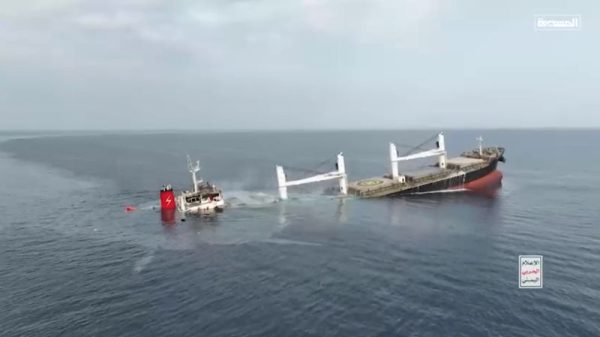On Good Friday 2017, Wyatt Werneth got a call from his wife, who had gone grocery shopping with their daughter: The car’s broken down. Please rescue us.
Werneth hopped in his vehicle to assist, driving by Patrick Space Force Base near Cape Canaveral, Florida. From the A1A highway, Werneth said you can see the ocean.
What he saw next was a twist of fate that led to a much more urgent kind of rescue.
“When I came over the berm, I did not realize what I was getting into. There were multiple people in the water.”
And they were in trouble. Very serious trouble. Rip current kind of trouble.
The scene would send chills of dread down anyone’s spine — but at least Werneth was prepared. He is an experienced lifeguard instructor and had water rescue equipment with him.
But with at least five people struggling in a vicious Atlantic rip current, how would he possibly save them all?
The statistics are grim
Rip currents could be a major hazard along much of the US Atlantic coastline during this Labor Day weekend because of tropical storm systems hundreds of miles out churning up the sea. And with temperatures so high, the desire to take a dip in the water will be strong.
Be cautious, check local conditions and see below for more details about what to do if you’re caught in one.
Whether it’s from these potentially dangerous currents, seemingly placid lakes or swimming pools, the drowning statistics from the US Centers for Disease Control and Prevention are shocking.
In the CDC’s most recently updated numbers, an estimated 4,012 fatal unintentional drownings happen every year in the United States (including boating incidents). That is an average of 11 drowning deaths per day.
From 2016 to 2020, the states with the most drowning deaths per 100,000 people were the following:
1. Alaska
2. Hawaii
3. Louisiana
4. Florida
5. Montana (which replaces former No. 5 Mississippi)
Your odds of drowning are much, much higher than being attacked by a shark or an alligator.
World drowning statistics are even more shocking. There are an estimated 236,000 annual drowning deaths worldwide, according to the UN’s World Health Organization. That comes out to an average of 647 people per day.
And then there are the even more numerous nonfatal drownings. The CDC says people who survive a drowning incident have a range of outcomes: “From no injuries to very serious injuries or permanent disability.”
The tragedy is many of these deaths and injuries are preventable, experts say. What can you do to enjoy the water — be it ocean, river, lake or swimming pool — safely and not join the ranks of drowning deaths? Turns out, a lot.
Who is most at risk?
Knowing who is likely to drown is critical. At-risk groups need the most attention. In the United States, those include the following:
• The youngest people: Children 1 to 4 have the highest drowning rates, the CDC says, mostly in swimming pools.
• Males: They account for nearly 80% of fatal drownings in the United States. More risk-taking behaviors and alcohol use are cited as reasons. Across the world, WHO reports males have twice the fatal drowning rate of females.
• Minority groups: Fatal drowning rates for American Indian or Alaska Native people 29 and younger are two times higher than for White people. For Black people, the rate is 1.5 times higher than for White people.
• People with seizure disorders: People with conditions such as epilepsy are at a higher risk for drowning, and that can happen in a bathtub.
Drowning prevention tips
The CDC emphasizes the importance of learning basic water safety skills, saying formal lessons can reduce the risk of drowning.
However, “children who have had swimming lessons still need close and constant supervision when in or around water,” the agency notes. Don’t get distracted by TV, books or the phone when watching children in the water.
If you’re drinking alcoholic beverages, stay out of the water and don’t go boating. Impaired judgment and slow reactions can lead to tragedy.
People in boats and weaker swimmers should wear life jackets, especially in open water.
And keep an eye on the weather. Exit if there’s a thunderstorm or heavy rains.
Know the water environments
Understand the waters you’re about to enter. Different bodies of water carry different types of dangers:
OCEAN RIP CURRENTS
Rip currents flow away from shore. They often form at breaks in sandbars and close to piers and rock groins.
Look for signs of a rip current before entering, says the United States Lifesaving Association. That can be “a narrow gap of darker, seemingly calmer water between areas of breaking waves and whitewater,” a difference in water color or “a line of foam, seaweed or debris moving seaward.”
How to survive an alligator attack — or better yet, avoid one entirely
Here’s what to do you’re caught in one:
• Stay calm. Rip currents don’t pull you underwater but do sweep you farther from shore.
• Don’t swim against the current. Try to escape by “swimming out of the current in a direction following the shoreline,” the USLA says. You may be able to escape by floating or treading water and ride the current out.
• If you’re in trouble, yell and wave for help.
If you’re not trained, don’t try to rescue people yourself. Seek a lifeguard, call 911 or throw a flotation device their way. Direct the person to swim parallel to the shoreline to escape.
OTHER OCEAN TIPS
The National Weather Service warns swimmers to watch out for “shorebreak” waves. They crash directly onto the sand and can batter and disorient swimmers. “When in doubt, don’t go out,” said Wyatt Werneth, who is also the public service spokesperson for the American Lifeguard Association.
Swim Guide and Swim Ireland advise people to swim in the hour before or the hour after low tide or high tide when waters are generally calmer. (But conditions can vary beach to beach).
RIVERS
Tubing and other activities are popular in rivers. But swift currents and obstacles below the surface or debris can be hazardous.
Werneth said research the river before you enter.
LAKES AND PONDS
The placid waters of lakes and ponds can lull waders and swimmers into a false sense of security. Sharp, sudden dropoffs and debris under the water can startle or entangle people, Werneth said, leading to panic and drowning. He said go in with a swim buddy.
Dive only in designated areas. The USLA says enter unknown waters feet first to avoid striking your head. Swimmers shouldn’t stray into areas where personal watercraft and boats are speeding by.
SWIMMING POOLS
The National Drowing Prevention Alliance has this advice for pool owners: “four-sided fencing with self-closing self-latching gates, door and window alarms, and safety covers can help make sure kids don’t get to the water unsupervised.”
And even if your children know how to swim, adults should still maintain a careful watch. Keep flotation devices on hand.
BOATING
The National Park Service’s “Operation Dry Water” reminds people that all vessels must carry personal flotation devices.
National lifeguard shortage
Werneth, who is also a spokesman for the American Lifeguard Association, warned of a critical lifeguard shortage at the beginning of summer.
He said the group’s message has always been “swim in front of a lifeguard.” But he said the reality of the shortage is prompting a new one: “Learn to swim, America.”
“We want people to self-lifeguard. Assign someone in your family to be a water watcher. Have that person learn CPR.”
And if someone can’t swim and still wants to wade, “put a life jacket on them. That’s going to make a difference.”
Werneth said that if you plan on going to a destination that features water activities, go online first to find out the lifeguard situation and adapt your plans as needed. Some pools, lakes and beaches might not even be open.
Operation Rescue
Back in 2017 at that Florida beach, Werneth’s task was daunting. But he had a cool head, decades of experience — and fortunately, a second experienced helper on hand that he later learned was from the Air Force.
“He was single-handedly pulling people out before I even got there. … That Air Force guy was kind of coming back with one. I saw that he had one that was kind of going unconscious, and I immediately jumped in the water, swam out, grabbed the unconscious person and got him out.”
You come across a bear. Your next move is very important. Do you know what to do?
Werneth guesses that they were about 50 yards out, and he recalls they ended up pulling five male teens out of the water. They weren’t even in swimming attire, Werneth said, leading him to think it was a spur-of-the-moment decision to enter the ocean.
Would the group have died without the rescue, which left him exhausted?
“I assure you they all would have. … These people were going in to help each other, and it caused a chain reaction. Do not go into the water to assist anyone without a flotation device,” he said.
“It was perfect timing that I showed up and happened to be there to help those guys.” All because the family car had broken down. But not everyone can rely on luck.
In the end, you need “water confidence,” gained by experience and respect for the water.
“The fear is what generates the panic which generates the drowning.”







































